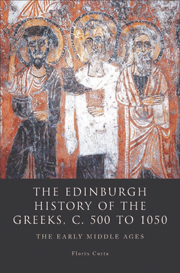Book contents
- Frontmatter
- Contents
- List of Illustrations
- List of Tables
- Acknowledgements
- Series Editor's Preface
- Introduction
- 1 The last century of Roman power (c. 500 to c. 620): army, church, and countryside
- 2 Collapse or adaptation? The problem of the urban decline in late antique Greece
- 3 Invasion or inflation? Hoards and barbarians in sixth- and early seventh-century Greece
- 4 Dark-Age Greece (c. 620 to c. 800)
- 5 Revival and expansion (c. 800 to c. 900)
- 6 The beginning of prosperity (c. 900 to c. 1050)
- 7 Early medieval Greece and the Middle Byzantine economy
- 8 Social structures and Byzantine administration in early medieval Greece
- 9 Christianity in early medieval Greece
- 10 Conclusion: the people of early medieval Greece
- Bibliography
- Index
8 - Social structures and Byzantine administration in early medieval Greece
Published online by Cambridge University Press: 05 August 2013
- Frontmatter
- Contents
- List of Illustrations
- List of Tables
- Acknowledgements
- Series Editor's Preface
- Introduction
- 1 The last century of Roman power (c. 500 to c. 620): army, church, and countryside
- 2 Collapse or adaptation? The problem of the urban decline in late antique Greece
- 3 Invasion or inflation? Hoards and barbarians in sixth- and early seventh-century Greece
- 4 Dark-Age Greece (c. 620 to c. 800)
- 5 Revival and expansion (c. 800 to c. 900)
- 6 The beginning of prosperity (c. 900 to c. 1050)
- 7 Early medieval Greece and the Middle Byzantine economy
- 8 Social structures and Byzantine administration in early medieval Greece
- 9 Christianity in early medieval Greece
- 10 Conclusion: the people of early medieval Greece
- Bibliography
- Index
Summary
The secular elites of sixth-century Greece formed an evanescent social group. By 500, most of them lived in urban villas lavishly decorated with mosaic floors or marble revetment, as in Argos, Delphi, or Athens (see Chapter 2). They laid their dead in frescoed burial chambers, often inside basilicas for the building or decoration of which they served as patrons (see Chapter 1). While urban villas completely disappeared before 600, the use of burial chambers attached or adjacent to existing basilicas continued well into the seventh century. However, those burying their dead in Nea Anchialos shortly after 600 neither had the same social status nor employed the same elements of material culture for the representation of their power as their sixth-century predecessors. Although the privileged status of the woman buried in a chamber built next to basilica Δ in Nea Anchialos was rendered visible by access to a Christian burial site, the message encoded in her burial dress combined cultural elements of different origins in an attempt to create a new way of expressing social power (see Chapter 4). Similarly, the ‘wandering soldier’ from Corinth was buried in a stone-lined grave – a type of grave most common in the circum-Mediterranean region – but with grave goods hinting at barbarian fashions from the Middle Danube region or the steppe lands north of the Black Sea. The archaeological evidence thus suggests that the withdrawal of the old, city-based aristocracy both from political life and, quite possibly, from Greece altogether was followed by a dramatic transformation of the cultural construction of social power.
- Type
- Chapter
- Information
- The Edinburgh History of the Greeks, c. 500 to 1050The Early Middle Ages, pp. 230 - 248Publisher: Edinburgh University PressPrint publication year: 2011



